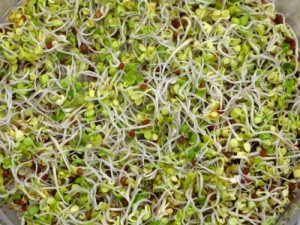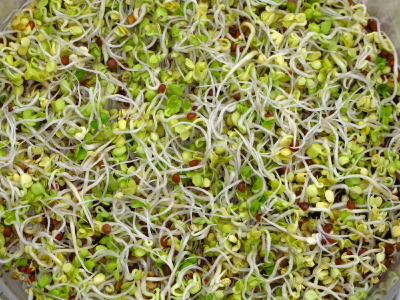Looking for more and better ways to incorporate nutritional foods in your diet? Try sprouting. With its numerous health benefits, easy preparation, and the many dishes you can make out of it, there’s no denying that sprouting is definitely one convenient hobby you should try out.
Sprouting and its numerous benefits
 Beans , legumes, grain, and seeds have several nutrients—but they also have anti-nutrients. These nutrients are locked up by anti-nutrients like phytic acid. By sprouting, these anti-nutrients are soaked away and you get to eat everything good the seeds have to offer.
Beans , legumes, grain, and seeds have several nutrients—but they also have anti-nutrients. These nutrients are locked up by anti-nutrients like phytic acid. By sprouting, these anti-nutrients are soaked away and you get to eat everything good the seeds have to offer.
Two anti-nutrients found in the seeds are phytic acid and enzyme inhibitors. Phytic acids are bound with magnesium, calcium, iron, zinc, and copper—thus making it difficult for your body to absorb these nutrients.
Enzyme inhibitors, on the other hand, not only inhibit the enzymes found in the seeds but even those found in your body. Foods with enzyme inhibitors make digestion very difficult. Just imagine your body’s natural digestive process being slowed down throughout your body because of suppressors found in the seed. As an effect, ingesting foods with enzyme inhibitors causes lethargy, obesity, bloating, and gastrointestinal difficulties.
What sprouting does is to soak away with these two anti-nutrients, allowing your body to fully absorb the seeds’ nutrients, all while reducing its enzyme inhibitors. The soaking process starts the production of beneficial enzymes which, together with Lactobacilli, neutralize the phytic acid.
Another way by which sprouting helps in digestion is by breaking down the complex vegetable proteins found in beans and legumes to simple amino acids. At the same time, its complex carbohydrates are broken down into more basic glucose molecules.
Quite fascinatingly, sprouting is responsible for turning grains and legumes from generally acid-forming foods to alkalizing agents. Sprouting is the first step to letting it grow into a plant. This transforms the seed into an alkaline forming food.
A quick comparison of sprouted grain with whole grain will also reveal that the former contains more nutritional advantages than the latter. Sprouting produces Vitamin C and increases Vitamins B2, B5 and B6. Sprouted grain also contains up to 35% protein and has a lower rating on the glycemic index, making it perfect for those with blood sugar problems.
Other nutrients found in sprouted seeds include potassium, zinc, phosphorus, calcium, chlorophyll, magnesium, iron, and niacin. Remember, because of anti-nutrients, these are precisely the nutrients you are depriving your body of!
Recent studies have also pointed out that sprouts have incredibly high levels of a cancer-fighting compound sulforaphane, which also supports in the absorption of antioxidants such as Vitamins C and E. As more carcinogenic compounds are found in our environment and the foods we eat, you can’t afford to overlook sprouts.
Also, unlike grocery-bought vegetables and fruits that lose their nutritional content by the time they make their way to the supermarket, sprouts are fresh, crisp, and raw. Sprouting gives you access to all these nutrients without the bane of preservatives.
How Sprouting Works
Sprouting is anything but labor-intensive. Unfortunately, the impression that it requires enormous effort is precisely what’s stopping people from sprouting their own grains and seeds. Sprouting is pretty much the same for all seeds—the only difference is the time it takes to grow them.
Choosing the right seeds
First, what are the seeds and grains that qualify for sprouting? Legumes and beans are the most popular. They should be fresh and alive—if they don’t sprout, then they’re “dead” and no longer contain nutrients and enzymes. Garbanzo beans, sunflower seeds, mung beans, wheat and rye berries, and mung beans are excellent for those who are just about to try sprouting out. Cabbage, mustard, radish, and buckwheat are also good choices.
Chickpeas, or garbanzo beans, are considered the most digestible. Once sprouted by around 1 to 2 cm, their enzyme inhibitors are considered neutralized. Mung beans are also quite popular, especially for Chinese dishes.
There are certain seeds and grains that are quite toxic, such as soybeans, kidney beans, and alfalfa sprouts. Soybeans and kidney beans retain the phytic acid, and will do nothing to prevent bloatedness and indigestion.
Optimizing the sprouting conditions
After making your choice of beans, ensure that the growing conditions are at its best.
Container – There are three choices: jars, bags, and trays. Jars are the most traditional, and are quite easy to find. However, they aren’t ideal for sprouts that require light; sprouts in the middle will not get enough light to grow properly. Trays are ideal for sprouts that need light, with its broad surface area. This will also allow sprouts to grow in naturally upward. Bags are for beans and legumes that don’t need too much light; they don’t take up a lot of space and at the same time allows air to properly seep through.
Air – The seeds will need air, just like any growing plant. If you deprive the sprout of air, they will rot and mould easily.
Water – Sprouts need to be soaked and watered around every 12 hours, and even more frequently if the weather is hot. Consistency is important—if you forget to water them in the first few days, their growth will be stunted. When watering them, strike a balance—too much water will drown them and too little will leave them to dry.
Space – Spread the seeds apart in such a way that they will be given room to grow. The sprouts will grow to around 30 times of their current size. If you put too much in the container, they will eventually compete for natural light, water, and air.
The Procedure
After picking out seeds that are broken, discolored, moldy, soak the seeds for around 8 hours or overnight in water. You may also add liquid feed for the plants. After soaking them, pour them through a sieve.
After this, rinse the sprouts for at least every 12 hours. Make sure not to move the sprouts around as they are taking root, but once they have, you can swish them about to remove the seed hulls. Drain the sprouts well, because standing water may cause rotting.
Rinse the grains until they have sprouted to at least 1 and 2 cm, or to your liking. This usually takes 3 to 6 days. Once you’ve rinsed the sprouts thoroughly for one last time then store them in a tight container. After this place the bag in a dark and cool place, usually in the refrigerator. It is best to consume them within five days.
Ways to enjoy sprouts
Now that you have your fresh and crisp sprouts, how do you go about enjoying them? Fortunately, there are quite a number of ways that are more than enough to sustain your interest and include sprouts in your diet plan. Two or more of the many dishes you can make from sprouts are bound to appeal not only to you but to everyone else in the family.
You can serve sprouts steamed, raw, or stir fried. The easiest ways is to steam them—simply put the sprouts over a steamer for around 5 to 8 minutes. In a quick while, they soften and be ready. Eating them raw is obviously one of the healthiest ways, advisable for bean sprouts. By eating them raw, you take in as many vitamins and minerals that would have escaped by heating them or frying them. However, make sure that you thoroughly wash them before eating. When stir frying sprouts, make sure you lightly sauté them to retain its crunchy texture.
Drinks
One is to make healthy drinks out of them sprouts. Use a juicer that has an extractor to create tasty drinks from sprouts along with other fruits and veggies such as oranges, carrots, and apples.
Salads
Salads are also one of the more popular options. Stir them into a bowl of tossed green salad. You can also spread light vinaigrette dressing on sprouts of different kinds. Combine sprouts with chopped pineapple, broccoli, and grapes—then add in a healthy dose of Greek yogurt and mayonnaise dressing. Sprouts also go well with Asian salads. Potato salad also goes great with sprouts.
Sandwiches
Sandwiches, be they vegetable or hot or cold meat, are best enjoyed with sprouts. Instead of lettuce, use sprouts. You can also fill tortilla shells with sprouts and the sandwich filling. Aside from being a lettuce replacement, it also works great as a celery replacement in sandwich spreads. Alfalfa, clover, and radish sprouts are best for these.
Soups and vegetables
Sprouts make for great vegetable side dishes. You can stir fry and mix them with minced ginger and garlic, or serve them over rice or noodles. Stir them with bean soup, vegetable soup or minestrone to give it a uniquely crunch flavor.
Asian food
Sprouts are among the most popular ingredients found in most Asian dishes. If you want to make your sushi extra flavorful, add some radish and sunflower sprouts. Saucy stir-fry bean sprouts, a popular Asian dish, can be done easily by stir frying the mung beans and adding a tablespoon of soy sauce. It’s incredibly easy that you can have them in just 10 minutes. Other examples of Asian dishes include egg rolls, shanghai noodles, spring rolls, and Vietnamese salad rolls.

Leave a Reply